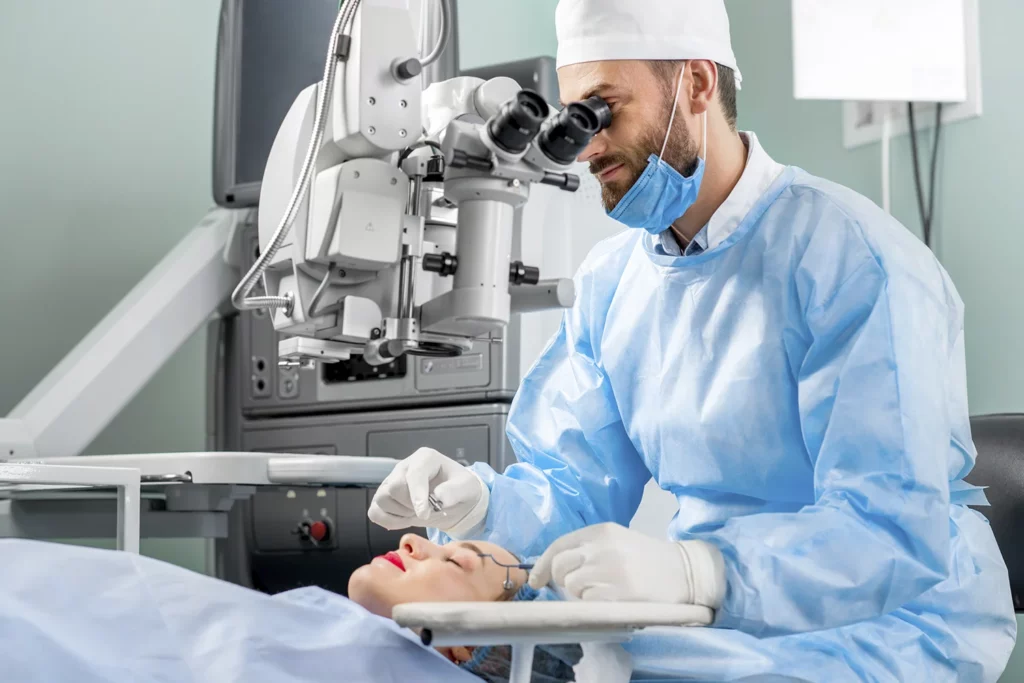Introduction to the Procedure
LASIK (Laser-Assisted In Situ Keratomileusis) is one of the most popular and effective laser eye surgery procedures designed to correct refractive vision problems, such as myopia (nearsightedness), hyperopia (farsightedness), and astigmatism. The procedure reshapes the cornea—the clear front part of the eye—using laser technology to improve how light is focused onto the retina. By doing so, LASIK can significantly enhance visual acuity and reduce the dependence on glasses or contact lenses, allowing individuals to enjoy clearer vision and greater freedom in their daily lives.
Stages of the Procedure
The LASIK procedure is carried out in several key stages, each designed to ensure patient safety and optimal outcomes:
- Pre-Operative Assessment: A thorough eye examination is conducted to determine the patient’s eligibility for LASIK. This assessment includes measuring the curvature of the cornea, evaluating overall eye health, and determining refractive errors.
- Numbing the Eye: Before the procedure begins, anesthetic eye drops are applied to numb the surface of the eye, ensuring the patient remains comfortable throughout the process.
- Creating the Corneal Flap: Using a microkeratome or femtosecond laser, a thin flap is created on the cornea. This flap is gently lifted to expose the underlying corneal tissue.
- Laser Reshaping: An excimer laser is then used to precisely reshape the corneal tissue beneath the flap. The laser removes microscopic amounts of corneal tissue based on the specific refractive error, allowing light to focus correctly on the retina.
- Repositioning the Flap: Once the cornea has been reshaped, the corneal flap is carefully repositioned over the treated area. The flap adheres naturally without the need for stitches.
The entire procedure typically takes about 10 to 15 minutes for both eyes, with the laser application lasting only a few seconds.
People Eligible for the Procedure
LASIK is suitable for a wide range of individuals looking to improve their vision. Ideal candidates include:
- Adults over the age of 18 with stable vision for at least one year.
- Individuals with myopia, hyperopia, or astigmatism that falls within the treatable range.
- Patients in good overall health without underlying eye conditions such as severe dry eyes, glaucoma, or cataracts.
- Those who have realistic expectations about the potential outcomes and understand that they may still require glasses for specific tasks, such as reading.
Individuals who are pregnant, nursing, or have fluctuating vision may need to postpone the procedure until their vision stabilizes.
Preparation Before the Procedure
Proper preparation is crucial for achieving optimal results from LASIK:
- Eye Examination: A comprehensive eye exam is conducted to evaluate the patient’s eye health and determine suitability for LASIK. The eye doctor will assess the cornea, pupil size, and refractive errors.
- Contact Lens Use: Patients who wear contact lenses are usually advised to stop wearing them for several days or weeks before the procedure, depending on the type of lenses. This allows the cornea to return to its natural shape.
- Medications: Patients should inform their eye doctor of any medications they are taking, as certain medications may need to be paused before surgery.
- Pre-Surgery Instructions: Patients receive detailed guidelines to follow in the days leading up to the procedure, including avoiding lotions, makeup, and perfumes that could interfere with the surgery.
Instructions After the Procedure
Following LASIK surgery, patients are provided with important aftercare instructions to ensure a smooth recovery:
- Resting the Eyes: Patients should rest for a few hours post-surgery. While many experience improved vision almost immediately, some discomfort or blurry vision is normal during the initial recovery period.
- Avoid Rubbing the Eyes: Rubbing the eyes can disrupt the healing process, particularly as the corneal flap needs time to adhere properly.
- Medicated Eye Drops: Patients are typically prescribed antibiotic and anti-inflammatory eye drops to prevent infection and reduce inflammation.
- Wearing Protective Eyewear: Patients should wear sunglasses when outdoors to shield their eyes from bright light and dust.
- Follow-Up Appointments: Regular follow-up visits with the eye doctor are crucial to monitor healing and ensure the procedure’s success.
Most patients can return to normal activities, including work, within a few days but should avoid strenuous activities and swimming for at least two weeks.
The Result
LASIK surgery yields immediate improvements in vision for the majority of patients, with many achieving 20/20 vision or better. The results can be transformative, eliminating or significantly reducing the need for glasses or contact lenses. Some individuals may experience minor side effects, such as dry eyes or glare, which usually improve over time. The long-lasting effects of LASIK mean that most patients enjoy improved vision for many years, although some may require a minor enhancement procedure later in life.
Why the Procedure at Royal Clinic in Turkey
Choosing Royal Clinic in Turkey for LASIK surgery comes with numerous advantages:
- Experienced Surgeons: The clinic boasts a team of highly skilled ophthalmologists with extensive experience in performing LASIK procedures, ensuring safety and precision.
- Advanced Technology: Royal Clinic utilizes the latest laser technology, including femtosecond and excimer lasers, which enhance accuracy and promote quicker recovery.
- Personalized Treatment Plans: Each patient receives a tailored treatment plan based on their unique vision needs and goals, maximizing the likelihood of successful outcomes.
- Comprehensive Care: From the initial consultation to post-surgery follow-up, Royal Clinic provides thorough support to guide patients through every step of their LASIK journey.
- Affordable Care: Turkey is recognized for offering high-quality medical services at competitive prices, making it an attractive destination for medical tourism. Patients at Royal Clinic can receive world-class LASIK surgery without the exorbitant costs found in many Western countries.
With its exceptional medical team, state-of-the-art technology, and patient-centered approach, Royal Clinic in Turkey stands out as a trusted provider for those seeking LASIK surgery to improve their vision and enhance their quality of life.





